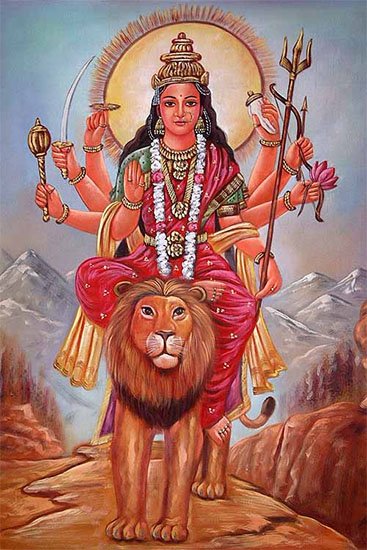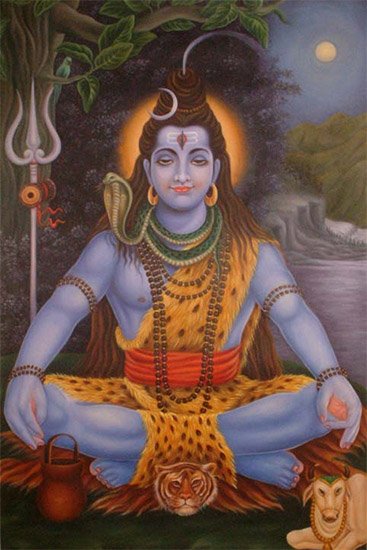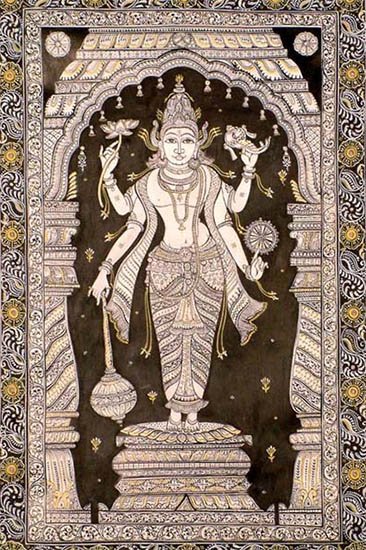Citrambara, Citrāṃbara, Citrāmbara, Citra-ambara: 4 definitions
Introduction:
Citrambara means something in Hinduism, Sanskrit. If you want to know the exact meaning, history, etymology or English translation of this term then check out the descriptions on this page. Add your comment or reference to a book if you want to contribute to this summary article.
Alternative spellings of this word include Chitrambara.
In Hinduism
Shaktism (Shakta philosophy)
Source: Google Books: ManthanabhairavatantramCitrāmbara (चित्राम्बर) refers to “clothes of various colours”, according to the Manthānabhairavatantra, a vast sprawling work that belongs to a corpus of Tantric texts concerned with the worship of the goddess Kubjikā.—Accordingly, “(Jvālāmaṅgalyā), the goddess born of Jāla is very dignified and powerful. She has five faces, four arms, and sits on a white lion. She holds sword, club, fetter, and goad and is adorned with jewels. She wears clothes of various colours [i.e., citrāmbara-dharā], is fierce and, when worshipped, bestows boons”.

Shakta (शाक्त, śākta) or Shaktism (śāktism) represents a tradition of Hinduism where the Goddess (Devi) is revered and worshipped. Shakta literature includes a range of scriptures, including various Agamas and Tantras, although its roots may be traced back to the Vedas.
Shaivism (Shaiva philosophy)
Source: Brill: Śaivism and the Tantric TraditionsCitrāmbara (चित्राम्बर) refers to “multi-coloured garments”, as quoted by Hṛdayaśiva in his Prāyaścittasamuccaya (verse 10.27-35).—Accordingly, “[...] The Mantrin, intent on attaining all manner of special powers, should perform the observance for the pāśupatāstra resolutely dressed in multi-coloured garments (citrāmbara-dhara) and with multi-coloured garlands and unguents. And upon the completion of one or another of these observances, he should pour upon himself Śiva-water that has been consecrated by recitation of his mantra over it from a pot. [...]”.

Shaiva (शैव, śaiva) or Shaivism (śaivism) represents a tradition of Hinduism worshiping Shiva as the supreme being. Closely related to Shaktism, Shaiva literature includes a range of scriptures, including Tantras, while the root of this tradition may be traced back to the ancient Vedas.
Shilpashastra (iconography)
Source: academia.edu: Dvādaśa-mūrti in Tamil Tradition (iconography)Citrāmbara (चित्राम्बर) refers to “one who wears garments of many colours”, according to the Śrītattvanidhi (verse 2.19-42) citing the Pāñcarātrāgama-Kriyapāda.—Mādhava’s Mien is like blue-lily, garments of many colours (citrāmbara) and eyes like lotus flowers. According to the Caturviṃśatimūrtilakṣaṇa, The Pāñcarātra tradition (describing Keśava) got a stronghold over the Vaiṣṇava tradition by about the fourth century CE, e.g. the Ahirbhūdhnya-saṃhitā and so its impact on the Tamil Paripāṭal and hymns of the Āḻvārs is quite natural.

Shilpashastra (शिल्पशास्त्र, śilpaśāstra) represents the ancient Indian science (shastra) of creative arts (shilpa) such as sculpture, iconography and painting. Closely related to Vastushastra (architecture), they often share the same literature.
Languages of India and abroad
Kannada-English dictionary
Source: Alar: Kannada-English corpusCitrāṃbara (ಚಿತ್ರಾಂಬರ):—
1) [noun] a piece of cloth having different colours in spots, stripes; a part-coloured cloth.
2) [noun] the clear sky in the night with stars.
Kannada is a Dravidian language (as opposed to the Indo-European language family) mainly spoken in the southwestern region of India.
See also (Relevant definitions)
Partial matches: Citra, Ambara.
Starts with: Citrambaradhara.
Relevant text
No search results for Citrambara, Citrāṃbara, Citrāmbara, Citra-ambara, Citra-aṃbara; (plurals include: Citrambaras, Citrāṃbaras, Citrāmbaras, ambaras, aṃbaras) in any book or story.